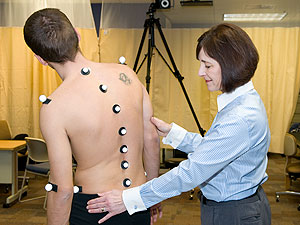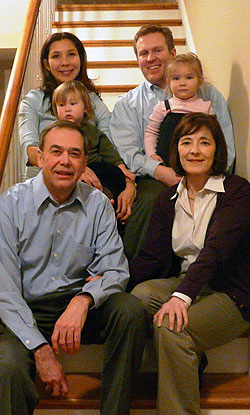Linda Van Dillen did not always want to be a physical therapist. She thought she would major in biology at the University of Missouri-Columbia. But after talking to a college friend who was very excited about going into the field of physical therapy (PT), she investigated the degree and was hooked.

“I realized that a degree in PT would allow me to use my basic science education and allow me to work with people,” says Van Dillen, Ph.D., associate professor of physical therapy and of orthopedic surgery. “Physical therapists were educated at the bachelor’s degree then — now we’re at the doctorate level. That’s how long ago it was!”
The “long ago” was in 1975, just after she graduated from Rosati-Kain High School, a few blocks from her current office. The field wasn’t necessarily new, but admission to PT programs was very competitive, as it is today.
“Physical therapy was very selective, and the classes were small — I came out of a class of 26,” she says.
She interviewed at several places after graduation, thinking she’d practice anywhere but in St. Louis. But, she ended up at Washington University — about five miles from where she grew up with her parents, two brothers and three sisters — and has been here ever since.
“I heard there was a job at Washington University,” she says. “Not knowing who to contact to apply, I called the admissions office of the physical therapy educational program. I was fortunate because Dr. Steven J. Rose, then the director of the Program in Physical Therapy, was also the director of the physical therapy clinical services at the Irene Walter Johnson Institute of Rehabilitation (IWJ). Steve was a nationally renowned scientist and clinician in the field of PT.
“Fortunately, I didn’t know that at the time, or I would have been really nervous,” she laughs.
Rose, Ph.D., hired her without knowing exactly where she would work, but he knew she was a good fit.
Van Dillen began as a staff physical therapist in the PT Neurology Service at IWJ. Within 18 months, she was moved to a senior physical therapy position and later was promoted to supervisor. Under her leadership, physical therapy clinicians built a comprehensive service for neurological rehabilitation that included acute care, inpatient and outpatient rehabilitation and home health care. The clinicians followed their patients across levels of care to see how they responded at different stages of their condition.
“Before this system, a therapist would see a patient in the hospital and would not know how the treatment affected the patient in the home after discharge,” Van Dillen says. “With the clinicians following patients across levels of care, it became clear how to best direct acute service care to help the patient manage after discharge.”
Evidence-based care
In the 1980s, Van Dillen became increasingly bothered by the lack of evidence-based treatment in the field. She returned to school to earn a master’s degree in health science in physical therapy at WUSTL, which gave her hands-on experience with the research process. Van Dillen said her master’s experience made it clear that if she wanted to conduct sound research, she needed more training.

“I decided that I needed to go back and really learn the scientific process well to effectively examine if anything we were providing to patients in PT really made a difference,” she says. “Around this time, there was a movement in my profession to identify clinical as well as basic science evidence underlying PT, and my generation initiated bridging that gap.
“When Dr. Rose came to Washington University in 1979, he initiated a research agenda for PT and brought the education, clinical care and research together,” she says. “This approach was unique, and the structure and philosophy of the Program in Physical Therapy now is a model for many other PT programs across the U.S.”
Van Dillen pursued a doctorate in experimental psychology at WUSTL and studied under Richard Abrams, Ph.D., professor of psychology in Arts & Sciences, in his perceptual-motor laboratory. The work served as a model to conduct very structured experiments of movement behavior in humans and to get background in research design and analysis that could be applied to a different area of investigation.
After she earned a doctorate, Van Dillen began studying musculoskeletal pain problems at the suggestion of Shirley Sahrmann, Ph.D., professor of physical therapy, of cell biology and physiology and of neurology.
“Shirley pointed out that people in her clinic with musculoskeletal pain displayed very stereotypical movement patterns that appeared to contribute to their pain problem,” Van Dillen says. “They were similar to my patients with neurological conditions who typically develop stereotypical movement patterns as a result of their nervous system condition. The thought was that people with musculoskeletal pain develop specific movement patterns as a result of activities that they perform repetitively.”
Challenging research
The major focus of Van Dillen’s funded work has been on the study of musculoskeletal pain, particularly spinal pain conditions.
“Spinal pain conditions are among the most common conditions referred to outpatient PT,” she says. “Spinal pain conditions have a huge impact on the quality of life and have enormous economic and social consequences that impact the public health-care system,” she says. “Low back pain is a general diagnosis, in many cases not consistently linked to a specific pathoanatomy, and that makes it difficult to know how to treat the condition.”
|
Linda Van Dillen |
|
Education: : B.S., 1979, University of Missouri-Columbia; M.H.S., 1985, and Ph.D., 1994, Washington University Titles: Associate professor of physical therapy and of orthopedic surgery; director, Musculoskeletal Analysis Laboratory Family: Friend Mark Mieners; mother, Rose Van Dillen; brothers James and Don Van Dillen; sisters Nancy Cavedine, Sue Hurst and Joyce Mueller; 20 nieces and nephews. Hobbies: Spending time with family, playing tennis, cycling, hiking and keeping up with the world by reading The Economist and BusinessWeek and biographies and autobiographies of political figures. |
Sahrmann says Van Dillen’s research approach is unmatched.
“Linda has systematically put real substance behind theory in an area that is not easy to break into,” Sahrmann says. “In addition to the typical challenges of grant funding, she has to fight the battles associated with breaking into new territories.”
With grant funding, her team has studied trunk movement in people with low back pain who regularly participate in racquet sports, a repetitive activity.
The researchers proposed that trunk movements used repeatedly in the racquet sport would contribute to the development of stereotypical movement strategies that people use in other activities. The repetition of the same movement strategies during the day was proposed to contribute to the low back pain.
“Using a structured clinical examination and laboratory measures, we subgroup people with low back pain based on the specific movement pattern they consistently display and the associated symptoms,” Van Dillen says. “We can then examine what factors contribute to why they move in a particular way. This gives us a basis for treatment, where we focus on modifying the contributing factors to alleviate the related low back pain symptoms and functional limitations.”
Van Dillen is conducting a Phase I clinical trial that involves people with low back pain based on their movement and alignment patterns identified with a standard clinical examination. Participants are then randomly assigned to one of two treatments to determine which results in the best outcomes.
Van Dillen’s published work has taken her around the world — she has attended conferences in Spain, the United Kingdom, Canada and Australia. She’s set to go back to Australia this year to the University of Queensland for a consensus conference on treatment of the spine.
“Linda is a wonderful citizen of our program and has brought us great distinction,” says Susie Deusinger, Ph.D., executive director of the Program in Physical Therapy and professor of physical therapy and of neurology. “Her logical and organized approach makes her a wonderful researcher.”
In the meantime, Van Dillen stays busy with her friend Mark Mieners and enjoys entertaining in their Central West End condominium.
“We like to cook, so when people come into town to work with us in our laboratory, we will have a few people from the lab, and a few faculty members come over. It gives us a chance to get to know everyone away from the work setting,” she says.